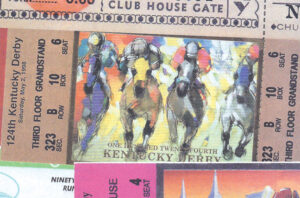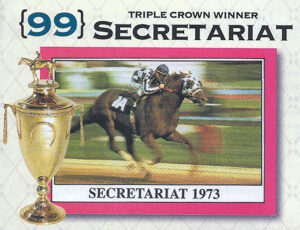 By Robert Reed
By Robert Reed The thundering hoofs on race tracks across America also echo the accompanying sound of horse racing collectibles. From programs and postcards to the individual memorabilia of legends like Seabiscuit and Secretariat, the ‘race’ to acquire a ‘bit’ of the horse racing past continues.
It doesn’t hurt that there are more than 90 thoroughbred race tracks in the country at the present time and plans for more at the starting gate. And figure includes only mounted horse racing and not equally colorful harness racing which involves a sulky.
Seabiscuit maybe one of the most recent examples of the growing popularity of the sport’s racing collectibles in general and race horse idols in particular. During the summer of 2003 a major motion picture drew national attention to the remarkable race horse. Interestingly there was a notable auction of Seabiscuit memorabilia shortly after the movie’s premier. A site in Beverly Hills, California sold original contacts, riding silks and crops, vintage racing photographs, and even Seabiscuit’s horse shoes and saddle.
The movie was actually the second time for racing wonder Seabiscuit who was more or less immortalized in the 1949 film by the same name. Although the 2003 version is credited with being more realistic, the earlier version with Shirley Temple in one of her first adult roles was a sensation at the time.
Today both the movie’s artifacts and those of the real-life race horse attract considerable attention from collectors.
The enduring story of Seabiscuit not withstanding, great race horses and great races have been a part of United States history for centuries. Horse racing was widely accepted in Colonial America, and historical accounts say even President George Washington himself was a riding competitor during his younger days. Moreover, according to the Pennsylvania Horse Racing Association, many of country’s city and county roads developed into thoroughfares for racing horses and thus Race Street is a common designation for some roadways yet today.
 By the second half of the 19th century major horse racing events were being established for an eager public. Among them were the Belmont Stakes, the Preakness Stakes and the Kentucky Derby. Now some of the programs for horse racing events in the 1860s, 1870s, and 1880s can be worth one thousand dollars or more in quality condition. And for those who didn’t quite make it to the track there were related amusements such as the Derby Steeple Chase game produced by McLoughlin Brothers in the 1880s and 1890s.
By the second half of the 19th century major horse racing events were being established for an eager public. Among them were the Belmont Stakes, the Preakness Stakes and the Kentucky Derby. Now some of the programs for horse racing events in the 1860s, 1870s, and 1880s can be worth one thousand dollars or more in quality condition. And for those who didn’t quite make it to the track there were related amusements such as the Derby Steeple Chase game produced by McLoughlin Brothers in the 1880s and 1890s. The popularity of horse racing rose to a full gallop early in the 20th century with a proliferation of significant race tracks and championship horses. Each track contributed a fascination of opening day programs, tickets, official scorecards, and officially commissioned photographs. In 1926 the owners of the Miami Jockey Club authorized hand-colored photographs of the Club’s grandstand and track. Decades later a framed and dated example brought several hundred dollars at Leland’s sports auction in New York.
During the 1930s a horse named Omaha became a triple crown winner, Hialeah Park billed itself on color postcards as the “most beautiful race course” in the country and Whitman Publishing issued the first edition of the Kentucky Derby Racing Game. During that same decade Time magazine added to the field of horse racing collectibles by putting a horse name Cavalcade on the cover of their national publication, and the Kentucky Derby began issuing mint julep drinking glasses to track visitors.
Ultimately the Kentucky Derby glass became one of the most familiar horse racing collectibles in history. In 1940 the traditional Derby ‘glass’ was made of aluminum. Starting in 1941 and continuing through the years of World War II the Derby glass was made of a type of celluloid due to the rationing of many other raw materials. The Beetleware containers included the image of a race horse along with a Bettleware label at the bottom of the glass. A single surviving Kentucky Derby glass of the early 1940s can command a price of several hundreds dollars currently.
Elsewhere in 1940s, a horse called Citation became a Triple Crown winner, jockey Eddie Arcaro appeared on the cover of Time magazine, and the Milton Bradley company marked a new game acknowledging wagering a race tracks with the title Win, Place & Show.
Native Dancer was one of the few race horse celebrities to make the cover of Time in the 1950s. Jockey Eddie Arcaro meanwhile made the cover of a newly introduced sports magazine during the 1950s. Sports Illustrated also featured jockeys Willie Hartack and Willie Shoemaker on covers during that same decade. Sports Illustrated ‘covered’ a number of Kentucky Derby winners during the 1960s, and one individual jockey, Willie Hartack. In 1969 President Richard Nixon paused to autograph a Kentucky Derby program that featured Majestic Prince. More than a generation later Leland’s sports auction sold the Nixon signed program along with his bow-tie press badge, and overhead view of the crowd of 106,000, and Nixon’s winning $2 ticket which was apparently never cashed in at the track.
Along similar celebrity-at-the-race track lines, Leland’s also auctioned at one time souvenirs of FBI chief J. Edgar Hoover’s visit to Pimlico. The lot included the G-Man’s lifetime pass to the race track, an uncashed pari-mutual ticket from 1972, and a letter to management from Hoover companion Clyde Tolson expressing thanks for sympathetic flowers at the time of Hoover’s death.
One of the greatest race horses of the 1970s was Secretariat. During the dramatic 1973 Belmont announcer Chick Anderson described the great horse as “moving like a tremendous machine” to set a world’s record at that race course. Secretariat made the cover of Sports Illustrated that same year. Other Sports Illustrated ‘cover’ horses of the 1970s included Seattle Slew, Affirmed, and Spectacular Bid. Eventually Secretariat, Seattle Slew and Affirmed also were featured in the official programs of the Kentucky Derby. Such magazines and programs profiling record-setting horses of the 20th century remain solid favorites with horse racing collectors.
In recent year Leland’s has also auctioned winning betting tickets for Secretariat which were somehow unclaimed. One recorded the grand horse’s victory at the 1973 Preakness, and another was a win in his final race at Woodbine. Both unusual collectibles were reported in mint condition.
While horse racing itself may still retain its ageless “sport of kings” title, it could well be considered by many to be a new prince of sports collectibles.















Follow Us